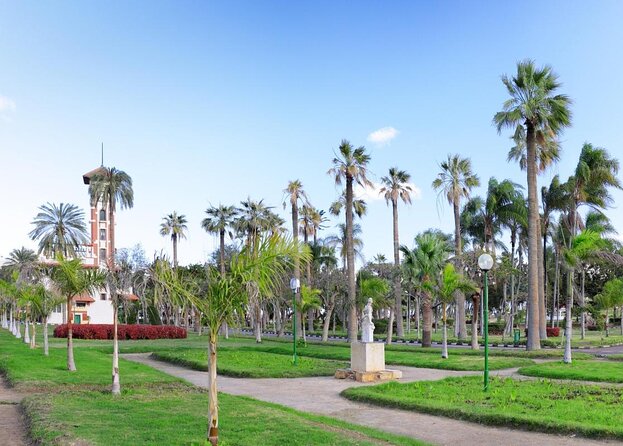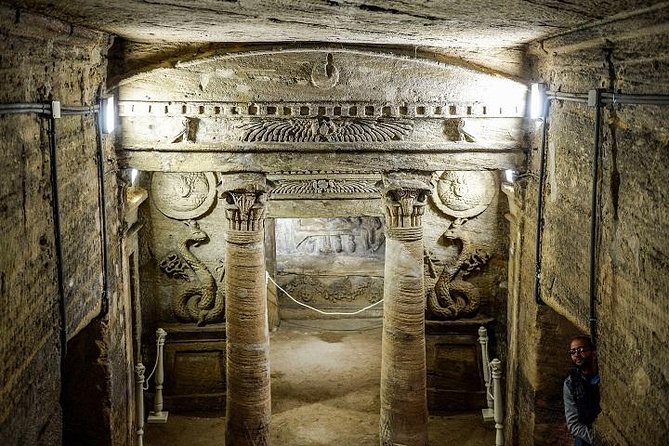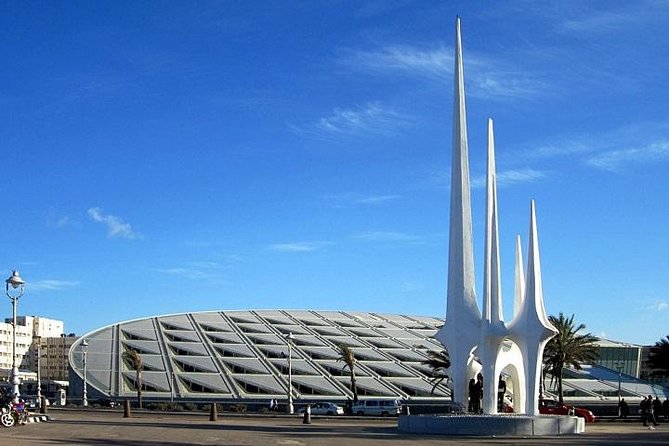In the heart of Alexandria, a tapestry of history unfolds through its iconic landmarks, each a brushstroke on the canvas of time. From the majestic Great Library to the enigmatic Catacombs of Kom El Shoqafa, the city is a treasure trove waiting to be discovered.
As the sun sets behind Pompey’s Pillar and casts a golden hue on the Citadel of Qaitbay, visitors are beckoned to explore further, intrigued by the secrets whispered by Montaza Palace and the Roman Amphitheater.
Along the Corniche of Alexandria, the waves of the Mediterranean Ocean carry tales of ancient glory, setting the stage for an adventure like no other.
Good To Know

- The Lighthouse of Alexandria, Pompey’s Pillar, Catacombs of Kom El Shoqafa, and The Great Library are historical landmarks.
- Citadel of Qaitbay, Montaza Palace, and Roman Amphitheater are architectural marvels in Alexandria.
- Cultural attractions include Catacombs of Kom El Shoqafa, The Great Library, and Roman Amphitheater.
- Coastal and scenic sites like Citadel of Qaitbay, Montaza Palace, and The Corniche attract travelers in Alexandria.
Overview of Alexandria’s Landmarks

Nestled along the coast of Egypt, Alexandria boasts a rich tapestry of historical landmarks waiting to be explored. The city is home to a myriad of historical monuments and architectural wonders that showcase its diverse heritage.
Visitors can marvel at the stunning remnants of the ancient Lighthouse of Alexandria, one of the Seven Wonders of the Ancient World. The impressive Pompey’s Pillar stands tall as a testament to the city’s grandeur in Roman times. The Catacombs of Kom El Shoqafa offer a glimpse into the fascinating fusion of ancient Egyptian and Greco-Roman art and architecture.
Alexandria’s landmarks not only tell the story of its past but also enchant travelers with their beauty and historical significance.
Find more activities and experiences we've covered in Alexandria.
The Great Library of Alexandria

Alexandria’s rich historical tapestry extends to the Great Library of Alexandria, a legendary repository of knowledge from ancient times. This monumental structure held an extensive collection of manuscripts, making it a beacon of learning and scholarship in the ancient world.
Founded in the 3rd century BC, the library attracted scholars, philosophers, and scientists, fostering a vibrant intellectual community. Its significance in history can’t be overstated, as it housed works from renowned thinkers like Euclid, Archimedes, and Eratosthenes.
Unfortunately, this bastion of knowledge met a tragic end, believed to have been destroyed in a series of events over centuries. Despite its physical absence today, the Great Library of Alexandria remains an enduring symbol of the pursuit of knowledge and the importance of preserving history.
Catacombs of Kom El Shoqafa
The Catacombs of Kom El Shoqafa are an underground burial site in Alexandria that showcases a unique blend of ancient Egyptian and Greco-Roman architectural styles. Exploration of these catacombs reveals a fascinating history dating back to the 2nd century AD.
Visitors can witness intricate carvings, statues, and reliefs that depict a fusion of Egyptian and Roman artistry. The catacombs served as a burial ground for multiple family members, with three levels extending underground, showcasing the evolution of burial practices over time.
Historians believe that the catacombs were lost and rediscovered by a donkey in 1900 after being buried beneath layers of debris. This historical site offers a compelling glimpse into the past, highlighting the cultural exchange between different civilizations.
Pompey’s Pillar
Explorers of the Catacombs of Kom El Shoqafa can continue their journey through Alexandria’s rich history by visiting Pompey’s Pillar, a towering ancient column that stands as a testament to the city’s past grandeur. This granite monolith, reaching over 25 meters in height, is one of the largest of its kind constructed outside of Rome.
Its historical significance lies in its association with the Roman Emperor Diocletian, rather than with Pompey himself, as the name suggests. The pillar’s Corinthian column is intricately designed, showcasing the architectural prowess of the ancient craftsmen.
Visitors can marvel at the sheer size and craftsmanship of this iconic structure, which has endured centuries of history and still stands proudly in Alexandria.
Citadel of Qaitbay
Perched majestically on the Mediterranean coastline, the Citadel of Qaitbay in Alexandria beckons visitors with its imposing fortifications and rich maritime history. This ancient fortress, built in the 15th century, stands as a testament to Egypt’s strategic location and architectural prowess.
As visitors explore the Citadel of Qaitbay, they’re immersed in a journey through time, delving into the depths of Alexandria’s captivating history and discovering the secrets held within its walls. Key highlights of the Citadel include:
- Stunning panoramic views of the Mediterranean Sea
- Intricate Islamic architectural details
- Historical artifacts and maritime relics on display
- Mysterious underground chambers waiting to be explored
- A glimpse into the military strategies of the past
- Mirette Tour in Alexandria From Alexandria Hotels and Alexandria Port
- Day Tour to Cairo From Alexandria Port & Alexandria Hotels
- Alamein Full Day Tour From Alexandria
- Cairo Private Full-Day Guided Tour From Alexandria
- Day Tour To Cairo From Alexandria
- Alexandria Day Tour From Aexandria Port (Archeological)
Montaza Palace
Located on the picturesque Mediterranean coastline, what intriguing historical stories does Montaza Palace hold within its elegant walls? Montaza Palace, a stunning royal retreat, boasts lush royal gardens that overlook the crystal-clear waters of the sea. Originally built as a summer residence for the Egyptian royal family, this architectural gem has transformed into a luxurious beach resort, blending history with modern elegance.
Visitors can wander through the palace’s opulent rooms and corridors, imagining the lavish lifestyle of the past rulers. The palace’s serene ambiance, surrounded by beautifully landscaped gardens, provides a peaceful escape from the bustling city. Montaza Palace stands as a testament to Alexandria’s rich history and is a must-visit destination for those seeking a glimpse into Egypt’s royal heritage.
Roman Amphitheater
With its ancient grandeur and historical significance, the Roman Amphitheater in Alexandria offers visitors a captivating glimpse into the city’s past. The site boasts impressive ancient ruins and stands as a testament to the rich history of Alexandria.
Here are some key points to know about the Roman Amphitheater:
- Built during the Roman period
- Once hosted gladiator fights and other entertainment
- Can accommodate up to 800 spectators
- Features well-preserved seating tiers and arena
- Offers a unique opportunity to take in the history of the region, showcasing the architectural and cultural heritage of ancient Alexandria.
The Corniche of Alexandria
Winding gracefully along the Mediterranean shoreline, the Corniche of Alexandria beckons visitors with its picturesque sea views and vibrant atmosphere. This iconic waterfront promenade stretches for miles, offering a delightful blend of coastal attractions and stunning vistas.
Stroll along the palm-lined pathways, breathing in the fresh sea breeze and taking in the sight of fishing boats bobbing in the harbor. The Corniche isn’t only a perfect spot for a leisurely walk or a relaxing bike ride but also a hub of activity, with cafes, restaurants, and shops lining the way.
As the sun sets over the horizon, the Corniche transforms into a magical place, where locals and travelers gather to enjoy the beauty of Alexandria’s coastline.
Frequently Asked Questions
Is There a Dress Code to Visit the Landmarks of Alexandria in Egypt?
When visiting landmarks in Alexandria, Egypt, dress code requirements should align with cultural norms. It is advisable to wear modest clothing, covering shoulders and knees. Respect for local customs enhances the experience of exploring historical sites and interacting with the community.
Are There Any Age Restrictions for Visiting the Landmarks?
Age restrictions are not typically imposed on visiting landmarks in Alexandria. However, travelers are advised to follow guidelines for respectful behavior such as avoiding climbing on monuments or touching ancient artifacts during the tour.
Can I Bring Food or Drinks to the Sites?
Visitors are advised to adhere to food restrictions at the sites. While some may offer picnic spots, bringing outside food/drinks could be limited. It’s recommended to check specific site rules beforehand to ensure compliance.
Are There Restroom Facilities Available at the Landmarks?
Restroom facilities at the landmarks offer accessible options and maintain high cleanliness standards. Visitors can expect convenient and hygienic amenities to enhance their experience while exploring the historical sites in Alexandria, Egypt.
Is Photography Allowed at the Landmarks?
Photography etiquette varies at landmarks. Respect cultural norms; ask before capturing images. Be mindful of surroundings and other visitors. Follow guidelines to preserve sites. Enjoy the experience while being respectful.
The Sum Up
Set out on a journey through the historic Landmarks of Alexandria and uncover the city’s rich cultural heritage with Oman Day Tours.
From the Great Library to Pompey’s Pillar, each site offers a glimpse into Alexandria’s fascinating history.
With personalized attention, private guides, and exclusive visits, this adventure promises an unforgettable exploration of iconic landmarks.
Don’t miss the chance to learn about the wonders of Alexandria’s past and create lasting memories of this enchanting city.
More Tour Reviews in Alexandria
- Group Tour to the landmarks of Alexandria from Alexandria city
- Half Day Tour to Bibliotheca Alexandrina (Library of Alexandria)
- Private Transfer Around El Nouzha Airport (Aly) in Alexandria
- Alexandria Free Walking Tours & Horse Carriage Ride by Night
- Giza Pyramids Sphinx, Memphis and Sakkara From Alexandria Port
- Over Day to Cairo Pyramids From Alexandria
Looking for something different? Other Alexandria activities we've written about
- Group Tour to the landmarks of Alexandria from Alexandria city
- Half Day Tour to Bibliotheca Alexandrina (Library of Alexandria)
- 2 Best Shopping Tours In Alexandria
- 3 Best Historical Tours In Alexandria
- 25 Best Tours In Alexandria
- 4 Best 2 Day Tours In Alexandria
- 12 Best Private Driver Services In Alexandria
- 9 Best Full-Day Tours In Alexandria
- 3 Best Boat Tours And Cruises In Alexandria
- 8 Best Guided Tours In Alexandria
- 5 Best City Tours In Alexandria
- 5 Best Airport Transfers In Alexandria
